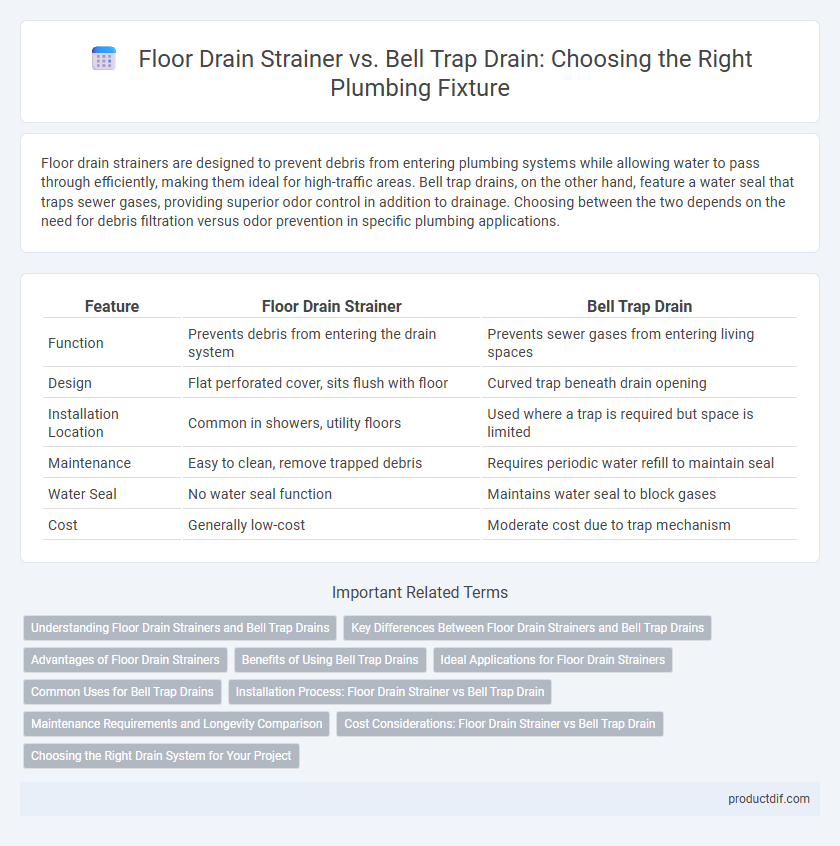Floor drain strainers are designed to prevent debris from entering plumbing systems while allowing water to pass through efficiently, making them ideal for high-traffic areas. Bell trap drains, on the other hand, feature a water seal that traps sewer gases, providing superior odor control in addition to drainage. Choosing between the two depends on the need for debris filtration versus odor prevention in specific plumbing applications.
Table of Comparison
| Feature | Floor Drain Strainer | Bell Trap Drain |
|---|---|---|
| Function | Prevents debris from entering the drain system | Prevents sewer gases from entering living spaces |
| Design | Flat perforated cover, sits flush with floor | Curved trap beneath drain opening |
| Installation Location | Common in showers, utility floors | Used where a trap is required but space is limited |
| Maintenance | Easy to clean, remove trapped debris | Requires periodic water refill to maintain seal |
| Water Seal | No water seal function | Maintains water seal to block gases |
| Cost | Generally low-cost | Moderate cost due to trap mechanism |
Understanding Floor Drain Strainers and Bell Trap Drains
Floor drain strainers are designed to prevent debris from entering plumbing systems by covering the drain outlet with perforated or mesh covers, ensuring efficient water flow while reducing clogs. Bell trap drains feature a unique bell-shaped chamber that traps water, creating a seal to block foul odors and sewer gases from rising into the living space. Selecting between floor drain strainers and bell trap drains depends on maintenance needs, odor control effectiveness, and suitability for specific drainage locations in residential or commercial plumbing systems.
Key Differences Between Floor Drain Strainers and Bell Trap Drains
Floor drain strainers are designed to cover floor drains, preventing debris and large particles from entering the drainage system while allowing water to flow freely. Bell trap drains incorporate a water seal that blocks sewer gases and odors from escaping into indoor spaces, providing an additional sanitary barrier. The key difference lies in functionality: floor drain strainers primarily filter solids, whereas bell trap drains combine filtering with odor prevention through their unique water-trapping design.
Advantages of Floor Drain Strainers
Floor drain strainers offer superior debris filtration, preventing clogs and reducing maintenance frequency compared to bell trap drains. Their robust design enhances water flow efficiency while minimizing odors, ensuring a hygienic and effective drainage system. Installation flexibility makes floor drain strainers suitable for various commercial and residential plumbing fixtures.
Benefits of Using Bell Trap Drains
Bell trap drains offer superior clog prevention by trapping debris before it reaches the main drainage system, significantly reducing maintenance needs. Their sealed design effectively blocks sewer gases and odors, enhancing indoor air quality in residential and commercial plumbing systems. Installation versatility allows bell traps to fit various floor drain configurations, making them a reliable choice for moisture-prone areas.
Ideal Applications for Floor Drain Strainers
Floor drain strainers are ideal for use in commercial kitchens, laundry rooms, and industrial settings where debris accumulation is common and requires prevention to maintain proper drainage. Their design efficiently captures solid particles while allowing water to flow freely, reducing the risk of clogs and ensuring sanitation compliance. These strainers are particularly suited for high-traffic areas with heavy water usage, providing durable, low-maintenance protection for plumbing systems.
Common Uses for Bell Trap Drains
Bell trap drains are commonly used in floor drain systems where preventing sewer gas escape is critical, such as in basements and bathrooms. Their design includes a water seal that effectively blocks unpleasant odors while allowing water to flow freely. These traps are ideal for installations with limited access to traditional P-traps, providing a compact and efficient drainage solution.
Installation Process: Floor Drain Strainer vs Bell Trap Drain
Floor drain strainers install directly into the drain opening, requiring minimal adjustments to the existing pipework and offering straightforward maintenance access. Bell trap drains demand more precise positioning during installation to ensure the water seal functions effectively as a trap, often involving alignment with both inlet and outlet pipes for proper odor control. Choosing between them depends on the complexity of the plumbing layout and the need for trap functionality versus simple debris filtering.
Maintenance Requirements and Longevity Comparison
Floor drain strainers require regular cleaning to prevent debris buildup and maintain efficient water flow, enhancing longevity with minimal maintenance. Bell trap drains often demand more frequent inspection and cleaning to avoid blockages and odors due to their water-trap design, which can be prone to sediment accumulation. Overall, floor drain strainers typically offer longer service life with simpler upkeep compared to the more maintenance-intensive bell trap drains.
Cost Considerations: Floor Drain Strainer vs Bell Trap Drain
Floor drain strainers generally have a lower upfront cost compared to bell trap drains due to simpler design and easier installation. Bell trap drains require more complex plumbing configurations, which can increase labor and material expenses. Long-term maintenance costs also tend to be lower for floor drain strainers because they are easier to clean and less prone to clogging.
Choosing the Right Drain System for Your Project
Selecting the appropriate plumbing fixture between a floor drain strainer and a bell trap drain depends on the specific requirements of your project's drainage system. Floor drain strainers are ideal for preventing solid debris from entering the drainage pipes, ensuring efficient water flow in commercial and residential settings. Bell trap drains excel in sealing off foul odors and gases from the sewage system, making them suitable for bathrooms and wet areas with drainage vents.
floor drain strainer vs bell trap drain Infographic

 productdif.com
productdif.com